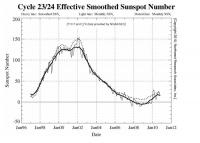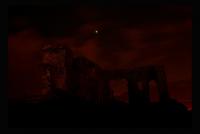Printable Version of Topic
Click here to view this topic in its original format
Unmanned Spaceflight.com _ Sun _ Solar Cycle 24 Begins
Posted by: Sunspot Jan 4 2008, 07:45 PM
Latest from spaceweather.com
SOLAR CYCLE 24: Solar physicists have been waiting for the appearance of a reversed-polarity sunspot to signal the start of the next solar cycle. The wait is over. A magnetically reversed, high-latitude sunspot emerged today: image. If you have a solar telescope, take a look at this important new active region. It marks the beginning of Solar Cycle 24 and the sun's slow ascent back to Solar Maximum.
http://sohowww.nascom.nasa.gov/data/realtime/javagif/gifs_small/20080104_1714_mdi_mag.gif
http://sohowww.nascom.nasa.gov/data/realtime/javagif/gifs_small/20080104_1600_mdi_igr.gif
Posted by: K-P Jan 5 2008, 12:38 PM
At least here it has been really sunny day, seems to be a good cycle coming... ![]()
Happy Birthday Sun!
Posted by: Sunspot Jan 5 2008, 12:43 PM
I'm really excited about this news. Apparently the earlier the cycle beings the more intense it is likely to be.
The spot group is JUST about visible in my telescope, hardly anything more than a few specs.. but a VERY important one!!
Posted by: nprev Jan 5 2008, 05:56 PM
Oh, joy. The last double-peaked beauty in '01-'02 royally messed up the Elmendorf AFB C-130 compass systems (rather, the associated geomagnetic storms did). Cycle 22's peak in '87-'88 did the same for A-10s I was working on in Arizona.
It sure was fun to try to explain that the Sun was doing this to a bunch of skeptical high-ranking officers as an enlisted guy, and later as a lowly civil servant. Fortunately, magnetic compasses on aircraft are being rapidly supplanted by dual or triple GPS-aided inertial nav systems these days.
Posted by: Canopus Jan 8 2008, 12:13 PM
Finally, and I'm glad! Solar minimum is sooooo boring. I know it'll take a while for solar activity to gear up. By 2011/12 I will have a solar telescope (what's the point of buying one now?), and look forward to massive sunspots and raging CME's. ![]()
Posted by: Sunspot Jan 11 2008, 06:03 PM
Even when the Sun appears blank in visible light there is still a lot to see in H - alpha and other wavelengths.
And more Sunspot strangeness reported on spaceweather.com:
CURIOUS SUNSPOT: A new sunspot is emerging just south of the sun's equator, and it is a curious one. The spot's magnetic polarity is reversed compared to other nearby magnetic patches on the sun's surface.
Reversed-polarity sunspots are signs of a new solar cycle and, indeed, Solar Cycle 24 began just last week. So far, so good. But this spot is near the equator. New-cycle spots are supposed to be at high latitudes--hence the curiosity. Is this a genuine new-cycle spot? A weird old-cycle spot?
http://www.spaceweather.com/images2008/11jan08/newspot_whitelight.gif
Posted by: Canopus Jan 19 2010, 01:29 PM
Funny. I last posted in this thread 2 years ago and NOW (finally...good grief) we are having continuous REAL solar activity.
The news in 2008 proved to be premature.
Now I'll consider buying a solar telescope.
Posted by: Sunspot Jan 19 2010, 02:17 PM
It is weird how in the last month the sun seems to have come to life. I suppose things good turn quiet again though - we've had a few false starts
Posted by: Canopus Jan 19 2010, 02:51 PM
Yes, that's occurred to me too.
Hopefully this Cycle has "taken" permanently. The minimum went on for far too long; geez.
Posted by: PhilCo126 Feb 9 2010, 05:24 PM
There's also some activity on our Sun's side that's turned away from us;
http://stereo-ssc.nascom.nasa.gov/beacon/beacon_secchi.shtml
![]()
Posted by: nprev Feb 9 2010, 10:50 PM
Just gotta express some love for STEREO, here. This is a brilliant mission on so many levels; for the first time, we really have comprehensive direct solar activity monitoring, and thus far that's been a somewhat underappreciated achievement.
Posted by: jamescanvin Feb 17 2010, 08:31 AM
Agreed, this thread isn't really appropriate. I've split the SDO posts off to a http://www.unmannedspaceflight.com/index.php?showtopic=6471
Posted by: PDP8E Dec 29 2010, 02:53 PM
Here is the latest (DEC-2010) update on Solar Minimum.
It looks like we are coming out.
It is safe to say that solar max will be low (80?) and late.
What does this say for Cycle 25?
Posted by: Gsnorgathon Dec 29 2010, 07:22 PM
Can someone help out those of us in the peanut gallery? How do you get a negative number of sunspots? ![]()
Posted by: JohnVV Dec 29 2010, 11:52 PM
from the standard average a "-" is possible
Posted by: djellison Dec 30 2010, 12:17 AM
I must be a mathematical dunce - how do you get an average of less than zero, when none of the sample values can ever be less than zero.
Posted by: nprev Dec 30 2010, 12:39 AM
I'm not seeing it either. According to http://spaceweather.com/glossary/sunspotnumber.html, the spot number R formula is R=k (10g+s), where g is the number of sunspot groups, s is the number of spots, and k is a constant based on seeing conditions, "usually" <1.
I can see it being zero, but not less than zero. Suspect that the chart is messed up.
EDIT: Possible sorta-solution. Notice that one of the three curves (the dotted line) does not dip below zero. Suspect that this is probably the actual observation number, and the other two curves are statistical products of some sort whose math is not readily obvious.
Posted by: Hungry4info Dec 30 2010, 02:04 AM
How much less? Only way R could be negative is if k < 0 (assuming physically meaningful values of g and s).
Edit: Found http://en.wikipedia.org/wiki/File:Sunspots_11000_years.svg. I don't know how much it applies since it doesn't seem to be a direct counting method.
Posted by: PDP8E Dec 30 2010, 04:03 PM
I have a request in with the scientists that produced the graph.
When he/they gets back after the New Year, I should have the mathematical artifact that explains the negatives.
Posted by: djellison Dec 30 2010, 04:34 PM
Where did it come from?
Posted by: PDP8E Dec 30 2010, 08:22 PM
Doug,
The graph came from www.NWRA.com (Northwest Research Associates). They are first rate consultants, scientists, -etc.
http://www.nwra.com/spawx/ssne-cycle2324.html
Posted by: nprev Dec 31 2010, 03:10 AM
My guess: They're using some sort of logarithmic expression in their calcs (any number below x exp 0 is gonna be negative.)
Posted by: djellison Dec 31 2010, 04:59 AM
Oh - I don't doubt that whatsoever. I'm just scratching my head on the fact that all the observations go sub-zero.
Posted by: Gsnorgathon Dec 31 2010, 10:01 PM
Note that none of the curves are observations - they're all calculated. So the mystery is just what is the calculation?
From http://www.nwra.com/spawx/ssne-cycle2324.html:
Please note that the SSNe values plotted here were calculated in near real-time from a limited data set. If you are interested in post-analysis SSNe values calculated from a more representative data set, please contact NWRA.
Posted by: PDP8E Dec 31 2010, 11:06 PM
Gsnorgathon is just about right.
Here is the email reply from NWRA:
....As indicated in the text on the referenced web page, the parameter in
question is an effective sunspot number, not an observed sunspot number.
It is more an index of the state of the ionosphere than of the sun,
although it does have a solar component. A negative value simply
indicates that the ionosphere is in a less-dense state than one would
expect for SSN=0. A more detailed explanation can be found in the link
"24hr SSNe" above the plot on the page you reference....
Posted by: PDP8E Jul 29 2011, 04:44 PM
The Sun is still a little sleepy
NSO is calling for a drop in solar activity
The Maunder Minimum event is referenced twice...(!)
http://www.nso.edu/press/SolarActivityDrop.html
Here is a great video from Goddard about the last big Solar CME
http://www.youtube.com/watch?v=3czPxBfOFOg&feature=player_embedded
Posted by: Sunspot Aug 9 2011, 09:49 AM
By far the largest flare of the cycle so far - X7
From SDO
http://sdo.gsfc.nasa.gov/assets/img/browse/2011/08/09/20110809_081058_1024_0193.jpg
Posted by: Sunspot Sep 26 2011, 09:40 PM
Very Strong geo magentic storm in progress, just saw the Aurora from Northern Cambridgeshire UK a few minutes ago.
Posted by: nprev Sep 26 2011, 11:34 PM
Man...First time in a LONG time I'm sorry we don't live in Alaska anymore. Enjoy the show, you guys!!!!
Posted by: Stu Sep 27 2011, 06:59 PM
Missed the amazing aurora last night because the STUPID SKY ABOVE KENDAL WAS *&^%$ %^**&&^& %^***£$££ CLOUDY AGAIN!!!!!!!!
But, minor - very minor! - consolation, I got to take this photo of Jupiter shining above my castle...
Posted by: Sunspot Sep 27 2011, 07:02 PM
My aurora pic is too embarrassing to post, its just a very thin strip of green beneath a gap in the clouds. If it had been completely clear it would have been quite impressive I think.
Posted by: SolarSystemRubble Sep 27 2011, 07:20 PM
I know how you feel. I went out to look at midnight and the only thing visible in the sky was Jupiter, barely.
Powered by Invision Power Board (http://www.invisionboard.com)
© Invision Power Services (http://www.invisionpower.com)


